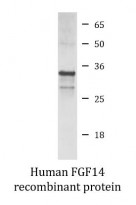ARG70121
Human FGF14 recombinant protein (Active) (His-tagged, N-ter)
Human FGF14 recombinant protein (Active) (His-tagged, N-ter) for SDS-PAGE
Overview
| Product Description | E. coli expressed, His-tagged (N-ter) Active Human FGF14 recombinant protein |
|---|---|
| Tested Application | SDS-PAGE |
| Target Name | FGF14 |
| Species | Human |
| A.A. Sequence | Ala2 - Thr246 |
| Expression System | E. coli |
| Activity | Active |
| Activity Note | Determined by its ability to induce 3T3 cells proliferation. The ED50 for this effect is < 21 ng/mL. |
| Alternate Names | FHF4; FHF-4; SCA27; Fibroblast growth factor 14; FGF-14; Fibroblast growth factor homologous factor 4 |
Properties
| Form | Powder |
|---|---|
| Purification Note | Endotoxin level is less than 0.1 EU/µg of the protein, as determined by the LAL test. |
| Purity | > 95% (by SDS-PAGE) |
| Buffer | PBS (pH 7.4) |
| Reconstitution | It is recommended to reconstitute the lyophilized protein in sterile water to a concentration not less than 200 μg/mL and incubate the stock solution for at least 20 min at room temperature to make sure the protein is dissolved completely. |
| Storage Instruction | For long term, lyophilized protein should be stored at -20°C or -80°C. After reconstitution, aliquot and store at -20°C or -80°C for up to one month. Storage in frost free freezers is not recommended. Avoid repeated freeze/thaw cycles. Suggest spin the vial prior to opening. |
| Note | For laboratory research only, not for drug, diagnostic or other use. |
Bioinformation
| Gene Symbol | FGF14 |
|---|---|
| Gene Full Name | fibroblast growth factor 14 |
| Background | The protein encoded by this gene is a member of the fibroblast growth factor (FGF) family. FGF family members possess broad mitogenic and cell survival activities, and are involved in a variety of biological processes, including embryonic development, cell growth, morphogenesis, tissue repair, tumor growth and invasion. A mutation in this gene is associated with autosomal dominant cerebral ataxia. Alternatively spliced transcript variants have been found for this gene. [provided by RefSeq, Jul 2008] |
| Function | Probably involved in nervous system development and function. [UniProt] |
| Cellular Localization | Nucleus. [UniProt] |
Images (1) Click the Picture to Zoom In






